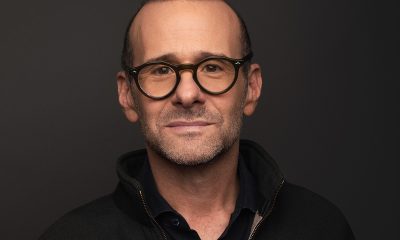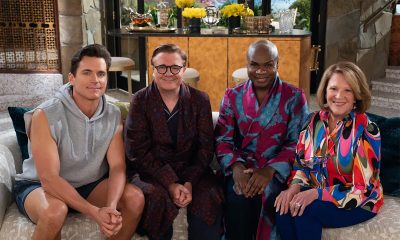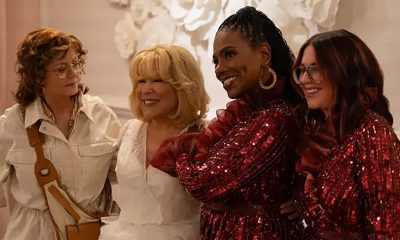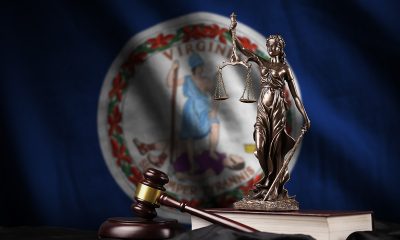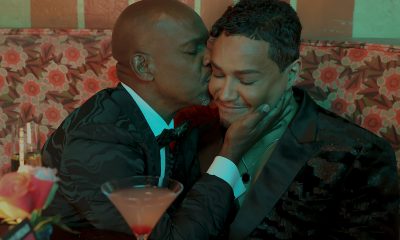a&e features
Megan Mullally bares all
From ‘Will & Grace’ to ‘Nancy and Beth,’ singer says music was her first love
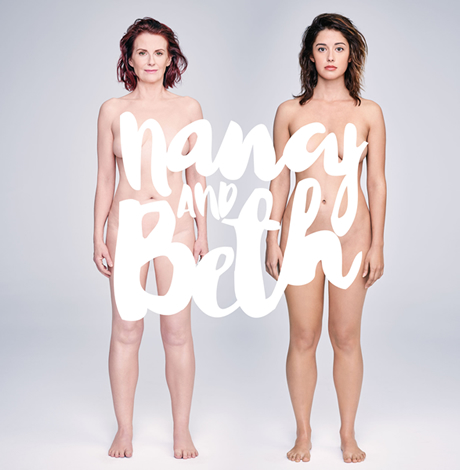
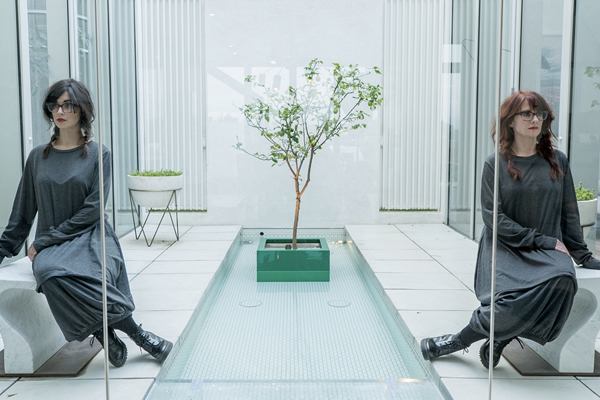
Actress/singer Megan Mullally, right, says her band with fellow singer STEPHANIE HUNT is a quirky, musically eclectic outfit that made sense instinctually. (Photo courtesy Kid Logic Media)
Nancy and Beth (Megan Mullally, Stephanie Hunt)
Monday, May 8
7 p.m.
U Street Music Hall
1115 U St., N.W.
$30
Megan Mullally cemented her legacy as the boozing and wise-cracking Karen Walker on the hit sitcom, “Will & Grace.” She later would go on to play opposite her husband Nick Offerman as his character’s ex-wife on “Parks and Recreation.” Since then, Mullally has started a side passion project with fellow actress Stephanie Hunt (“Friday Night Lights”), known as Nancy and Beth.
Bonded by a mutual love for quirk and music, the duo’s self-titled album is an eclectic mix of cover songs from rapper Gucci Mane’s “I Don’t Love Her” to the country classic, “He Stopped Loving Her Today” by George Jones. Mullally and Hunt bare it all on the cover art, appearing naked with the album’s title lettering strategically placed.
Mullally spoke with the Blade on the eagerly awaited “Will & Grace” reboot (a limited, 12-episode run with the original cast and crew on NBC is expected to air this fall), dropping her clothes for an album cover and the struggle to be taken seriously as an actress pursuing music.
WASHINGTON BLADE: Where did the name Nancy and Beth come from?
MEGAN MULLALLY: Nick, Stephanie and I had sat around at dinner one night and bounced around a bunch of band names and none of them seemed exactly right, but I wrote them all down. When I got back to Los Angeles I made a list of those, and a few others that I thought of, and I had thought of Nancy and Beth. For some reason it just seemed like the perfect name. I don’t know why. I stuck it in the middle of the list without any comment. I emailed the list to Stephanie and she emailed back right away, “Nancy and Beth.” I thought, well there you have it. That would be a good way of describing our entire vibe together. We’re completely on the same page. We have a real synchronous sort of affinity for each other.
BLADE: On the album cover, the both of you are naked. How did that concept come about?
MULLALLY: We’re both modest people. I don’t think Nick has ever seen me naked, for example. I’m not someone who rips my clothes off and goes galavanting about. I’m the opposite of that. I know Stephanie is too. I was in a very relaxed state one day and that image, exactly the way the album cover ended up being, came into my mind. Even though I didn’t want to take my clothes off necessarily, and I knew that Stephanie didn’t either, I pitched it to her and she was like, “Yeah we should do that.” It’s hard for me to put into words why I feel that’s the right record cover. It has something to do with bringing everything down to its most basic, elemental level. It’s the most stripped down, pure state. It’s two humans on the planet and we tried to keep it as absolutely neutral as possible. Except on the back cover art you see that we don’t mean it just as taking ourselves seriously, we also mean that there is humor included. I don’t think either one of us are very analytical people, we’re more instinctual.
BLADE: The music video for the single “Please, Mr. Jailer” has a quirky vibe paired with a classic song. Is that the vibe of the album?
MULLALLY: Yeah, it is. There’s only 10 songs on the record.They’re all a very eclectic mix from every genre, every era. Originally for the video there’s one rap song on the record by an artist named Gucci Mane. Initially I thought that should be the video because the track came out pretty well. It’s pretty funny. It’s not a comedy band at all, but that track has a lot going for it. So I sent it out to a bunch of people I know who are really good directors and said, “Hey do you want to direct our music video?” and for whatever reason everybody said no, mostly for scheduling reasons. It occurred to me that I didn’t want to get in a situation with a music video where we were going to have to sell our house and move into a tent so I thought, “Well I’ll just direct the music video.” And I thought we shouldn’t do that track because it’s an anomaly, it’s the only rap/hip-hop song on the record. We should do “Please, Mr. Jailer” which is more representative of our record as a whole and the spirit of the band. So I thought, I’ll just direct it and I’ll shoot it on my phone.
My pilates teacher, who is a really good friend of mine, I was talking to her about it and I realized that her husband is a really great VP, editor and director. So I thought, “Maybe I’ll just get Alex to come over and take some pictures or hold my phone.” Then I thought, “Wait, why don’t I just have Alex shoot it?” It was just really simple. We had a really easy shoot. It was just me, Stephanie, Alex and his assistant and hair and makeup. There was no other crew. It was all just very chill. I think it came out really well and I’m excited about it. The music video is more reflective of the tone of the album cover. So I think there’s an enigmatic quality that pulls you in that’s not necessarily reflected in our live show. Our live show we have facial expressions and every song is choreographed full-on. The video is different from the live show but I think the video is reflective of a weirdness that is inherent in my and Stephanie’s take on music.
BLADE: Lots of actors have musical side projects. Did you ever fear that the public wouldn’t take you seriously when you embarked on Nancy and Beth?
MULLALLY: Oh, I know they won’t. Nobody gives a shit if an actor does music. If a musician wants to act, people are like, “Oh my god. Amazing, brilliant.” If an actor reveals that they also have a musical side people are like, “Please, take your childish musical aspirations elsewhere.”
Well the fact of the matter is that I, and probably many other actors who also would like to express themselves musically, that was my start. I was into music way before I even thought about acting. I was in a ballet company. I was a serious ballet dancer for years also. I have done three musicals on Broadway and two of them were before “Will & Grace.” So two of them were before I was ever known as an actress on television. I think I’ve said that I came out the womb in a top hat and tap shoes. I’ve always loved music. Music has been the driving force in my creative life. It’s just that the public at large has no idea. They have not seen me in a Broadway musical. They don’t know anything about me being a singer. I’ve done a lot of concert singing. Singing is really my first, or maybe my best, thing. People don’t know that and that’s not their fault. It’s just the way it is. I don’t expect to ever sell one ticket, one record or anything. So each ticket or record that gets sold, I’m like, “Great. Bonus.”
BLADE: The last time you were on tour with Nancy and Beth your husband came along. Is he coming along this time?
MULLALLY: He is. Sometimes he’ll make an appearance during the show so we’ll see what happens. He’s our roadie.
BLADE: Fans are super excited for the “Will & Grace” reboot. Was it easy to slip back into the role of Karen Walker after so long?
MULLALLY: Frighteningly easy. I never doubted that it would be, but I also never thought there would be any reason for it to be. It never crossed any of our minds that the show would come back as the same exact show on the same exact network because that’s never happened before.
Although I did feel Karen was living a happy existence in some kind of alternative universe. It never occurred to me that universe would then be on NBC. It’s very exciting. I think the weirdest thing about the whole reboot is the fact that it doesn’t feel weird. It seems totally normal like we were just here two days ago, we went away for the weekend and we came back on a Monday. We’ve only had like two photoshoots and we’ve already just been like, “Hey” when we walk in like no time has gone by. We just had a photoshoot and I walked in and Eric (McCormack) and Sean (Hayes) were sitting there and I was like, “Hey guys” as I was heading to my dressing room. I came back and was like, “Wait a minute. No crazy casual, ‘Hey guys.’” This is great, we’re doing this. It’s crazy. It’s pretty fun. We’re already back to total, full-time groping, humping and laughing hysterically. It’s bizarre, nothing has changed.
BLADE: You’ve performed in D.C. before with your husband. What about D.C. makes it different from other cities you’ve performed in?
MULLALLY: I love D.C. as a city. I love performing there, the audiences there are great. I have a good friend who lives in D.C. She just organized this huge benefit for D.C. Public Libraries and they had two stages, music going all night, speakers, art installations. She sent me some stuff about it afterwards and one of the articles that was written about it had said how great it was that you live in a city where reading and libraries and that aspect of the culture, as well as all other aspects, are celebrated and all go hand in hand. I think that’s why D.C. is a great city for us to perform. I find our band entertaining across the board for all different kinds of audiences but at the same time its an eclectic band. I think the fact that we’re able to entertain everyone equally is a bonus so D.C. is a great city for that.
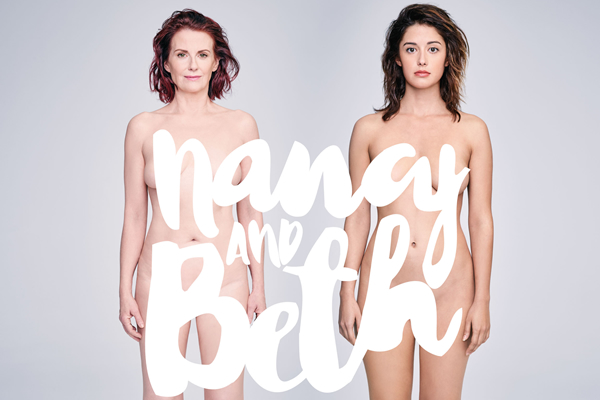
(Photo courtesy of Kid Logic Media)
a&e features
Doug Spearman takes his chance
‘Noah’s Arc: The Movie’ debuted on Paramount+ last month
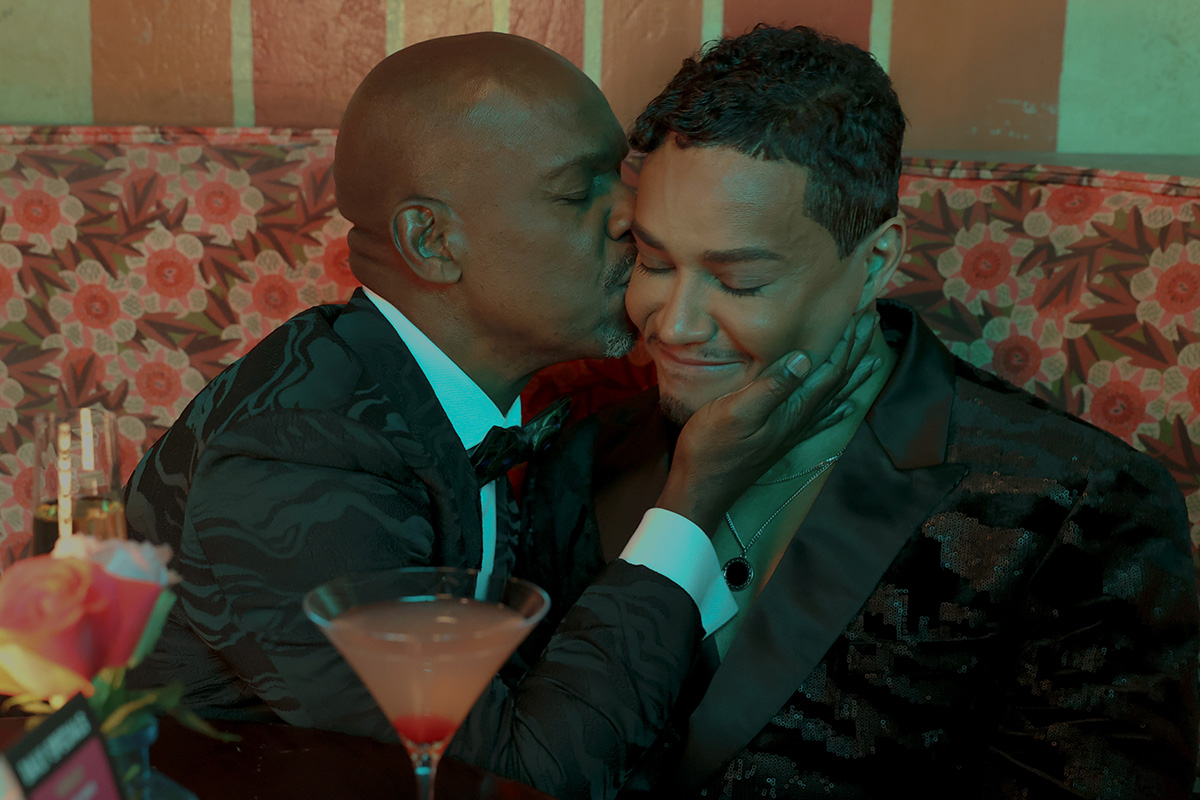
There’s no question that when Patrik-Ian Polk’s series “Noah’s Arc” premiered on Logo 20 years ago, it was a groundbreaking creation. The story of a group of Black gay men and their wonderful friendship. The titular arc was that of the cute main character, Noah (Darryl Stephens), and his close-knit circle of friends, including Chance played by gay actor Doug Spearman. This compelling and loving fraternity may, in fact, be what brought viewers back repeatedly, including a 2008 movie, “Noah’s Arc: Jumping the Broom,” as well as the 2020 “Noah’s Arc” short, and now, a new full-length feature “Noah’s Arc: The Movie,” debuting on Paramount+ on June 20. In the movie, filled with equal measures of laughs and tears, Chance, who has faced a devastating loss, finds his dependable friends there, ready to support and comfort him at a moment’s notice. I had the pleasure of speaking with Spearman the morning of the streaming premiere of “Noah’s Arc: The Movie.”
WASHINGTON BLADE: Doug, since the early 2000s, when the “Noah’s Arc” series premiered on Logo, you have been playing the character of Chance, including in the latest installment, “Noah’s Arc: The Movie.” What was it about Chance that appealed to you as an actor?
SPEARMAN: When Patrik (-Ian Polk) called me to ask me to play him (Chance), I was at JFK airport in the baggage claim, waiting for a suitcase. He explained what the part was. The thing that stuck out to me was the fact that Chance was in a long-term relationship with another Black man. And, they had a child; they had a 4-year-old daughter named Kenya. I had never seen two Black gay men raise a child on TV before. I thought it was the most revolutionary thing I’d ever seen. I immediately thought I’ve got to do this because that was something nobody had seen. I thought it was incredibly important to take the part.
BLADE: “Noah’s Arc: The Movie” was, once again, written and directed by Patrik-Ian Polk, who you just mentioned, is the creator of the entire franchise. What’s the secret to your long-standing working relationship?
SPEARMAN: [Laughs] the whole team, all of us, are like a band of brothers. We fight like brothers, we come together like brothers, we hash things out, we talk, because we’re all very different from our characters. I think the challenge of playing these guys and then uplifting these men, playing a part, especially something written by Patrik, is like solving a math equation. There’s always a challenge that’s enjoyable for me as an actor: to try to find out what it is that Patrik wants, and then how do I do it.
BLADE: I think you do a very good job of it.
SPEARMAN: Thank you very much
BLADE: In the years between “Jumping the Broom” and the new full-length movie, many changes have occurred, and the story addresses some of them, including gay widowhood, which is something that the aging community is now confronting, as well as mental health issues. Please say a few words about how you approached those subjects in the new movie.
SPEARMAN: I had a lot of loss in my life, right before we started shooting. Two months before we started shooting the first series, my mother died. I was going through the grief process through that whole first season. Since then, I’ve lost a lot of people in my life. In fact, when we started shooting the second season, the second week we were shooting, my ex died of a heart attack. I was having to fold that into what I was doing with my life on the set and off the set. You’ve got to show up and you’ve got to do your work. The first two seasons of “Noah’s Arc” are always tinged with the memory of grief. So, when I had to deal with the death that Chance faces (in the new movie), which is a significant death in his life, it wasn’t that hard to reach back, especially the scene in the graveyard. It was something that I unfortunately could pull from personal experience.
BLADE: Shifting gears, the movie features delightful cast surprises, including Jasmine Guy and TS Madison. Did you have a chance to interact with either or both when they were on set?
SPEARMAN: No, I didn’t have any scenes with Jasmine, and I missed her. I wish I had gotten to see her because I actually got to direct Jasmine for a CBS promo shoot for “Queen,” back in the early ‘90s. I had a huge crush on her when she was on “A Different World.” So, I really would have liked to reconnect. But TS and I got to see each other every day because I was in all her scenes. It was extraordinary being around somebody like that. That is one outspoken woman!
BLADE: Even though Beyoncé never makes an appearance in the movie, there’s a lot of talk about her. Would you say you are a Beyoncé fan?
SPEARMAN: Yes! I’m breathing! Yes, I’m a Beyoncé fan. I actually got the chance to meet her. I knew her mom. Her mom was extraordinary to me. She is in the second movie I directed. She also gave us a wedding gown to use in the very first scene of the movie. That family is extraordinarily important to me. Not only just to be a fan, but to be somebody who’s gotten to know them and work with them and see how hard they work. I don’t think anybody works as hard as Tina or Beyoncé.
BLADE: There was a recent news item about gay actor Benito Skinner of the Amazon Prime series “Overcompensating” being told not to bother auditioning for straight roles. As an out actor yourself, how important do you think it is for queer characters to be portrayed by queer actors, and vice versa?
SPEARMAN: Being queer is a multifaceted identity. There’s no one kind of queer person. I think finding the best actor that’s your first circle of casting. I think one of the joys about being an actor is that you get to play different parts. I play straight guys all the time. Dads and husbands and things like that. I think a lot of people are told not to do it. In fact, I wouldn’t be Chance if the actor who was originally cast as Chance hadn’t been pulled out of the series by his agents because they didn’t want him to play a gay character.
BLADE: That’s amazing! Thank you for sharing that. Without giving away too much, the ending of the movie is a little ambiguous, even ending with a question mark. If there was a “Noah’s Arc: The Movie” sequel, would you come back for that?
SPEARMAN: Yeah! A lot of it would depend on what Chance’s journey is going to be like. Patrik and I have conversations like that all the time. He’s very interested and supportive of input. I hope I would be, as we all would be, part of the creative growth with these characters. They live in Patrik’s head, and he writes them, but we’re the ones who have to flesh them out. It’s a conversation, it’s always a conversation.
BLADE: You are currently performing in Molière’s “The Imaginary Invalid” as part of the New Orleans Shakespeare Festival at Tulane. What has this experience been like for you?
SPEARMAN: It’s extraordinary! I started on stage when I was seven. There’s nothing like working with a live audience and having that immediacy. I’m working with an extraordinarily talented cast in a really great play, and I have some of the best scene partners I could ever want.
BLADE: Are there any upcoming film or TV projects you’d like to mention?
SPEARMAN: I’m still a writer, and I’m still a director, and I’ve still got scripts that I would like to make. I have a little something that’s a cross between “Treme” and “Bridgerton” that I want to do. I’m always trying to figure out what the next thing is.
a&e features
Visit Cambridge, a ‘beautiful secret’ on Maryland’s Eastern Shore
New organization promotes town’s welcoming vibe, LGBTQ inclusion
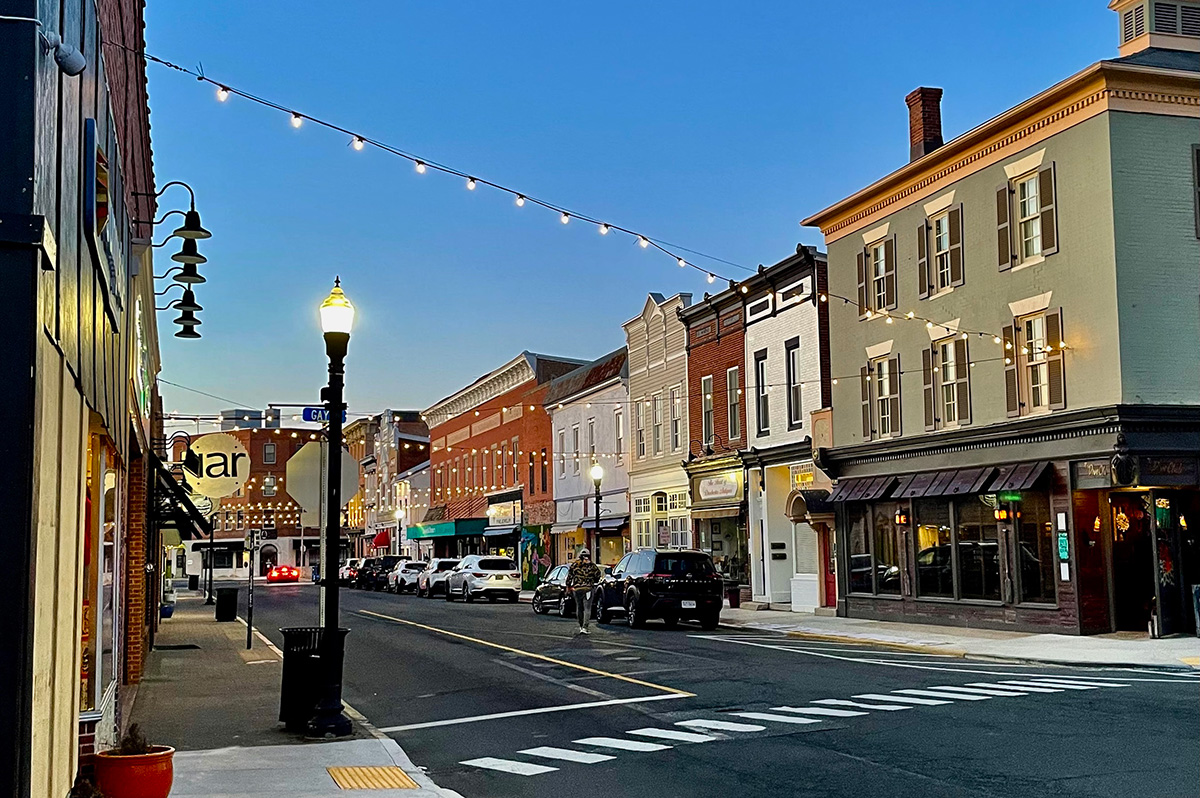
CAMBRIDGE, Md. — Driving through this scenic, historic town on Maryland’s Eastern Shore, you’ll be charmed by streets lined with unique shops, restaurants, and beautifully restored Victorian homes. You’ll also be struck by the number of LGBTQ Pride flags flying throughout the town.
The flags are a reassuring signal that everyone is welcome here, despite the town’s location in ruby red Dorchester County, which voted for Donald Trump over Kamala Harris by a lopsided margin. But don’t let that deter you from visiting. A new organization, Proudly Cambridge, is holding its debut Pride event this weekend, touting the town’s welcoming, inclusive culture.
“We stumbled on a beautiful secret and we wanted to help get the word out,” said James Lumalcuri of the effort to create Proudly Cambridge.
The organization celebrates diversity, enhances public spaces, and seeks to uplift all that Cambridge has to share, according to its mission statement, under the tagline “You Belong Here.”
The group has so far held informal movie nights and a picnic and garden party; the launch party is June 28 at the Cambridge Yacht Club, which will feature a Pride celebration and tea dance. The event’s 75 tickets sold out quickly and proceeds benefit DoCo Pride.
“Tickets went faster than we imagined and we’re bummed we can’t welcome everyone who wanted to come,” Lumalcuri said, adding that organizers plan to make “Cheers on the Choptank” an annual event with added capacity next year.
One of the group’s first projects was to distribute free Pride flags to anyone who requested one and the result is a visually striking display of a large number of flags flying all over town. Up next: Proudly Cambridge plans to roll out a program offering affirming businesses rainbow crab stickers to show their inclusiveness and LGBTQ support. The group also wants to engage with potential visitors and homebuyers.
“We want to spread the word outside of Cambridge — in D.C. and Baltimore — who don’t know about Cambridge,” Lumalcuri said. “We want them to come and know we are a safe haven. You can exist here and feel comfortable and supported by neighbors in a way that we didn’t anticipate when we moved here.”
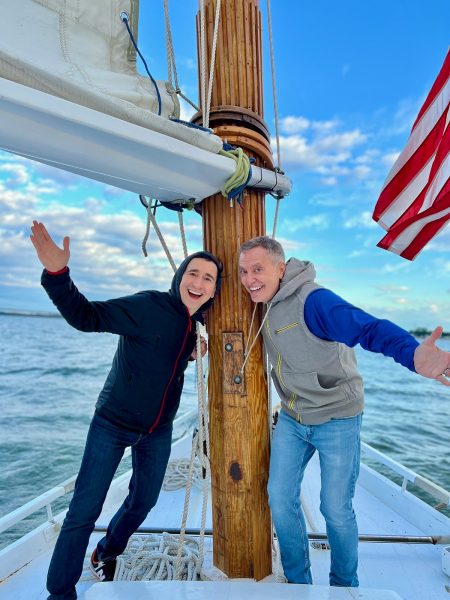
Lumalcuri, 53, a federal government employee, and his husband, Lou Cardenas, 62, a Realtor, purchased a Victorian house in Cambridge in 2021 and embarked on an extensive renovation. The couple also owns a home in Adams Morgan in D.C.
“We saw the opportunity here and wanted to share it with others,” Cardenas said. “There’s lots of housing inventory in the $300-400,000 range … we’re not here to gentrify people out of town because a lot of these homes are just empty and need to be fixed up and we’re happy to be a part of that.”
Lumalcuri was talking with friends one Sunday last year at the gazebo (affectionately known as the “gayzebo” by locals) at the Yacht Club and the idea for Proudly Cambridge was born. The founding board members are Lumalcuri, Corey van Vlymen, Brian Orjuela, Lauren Mross, and Caleb Holland. The group is currently working toward forming a 501(c)3.
“We need visibility and support for those who need it,” Mross said. “We started making lists of what we wanted to do and the five of us ran with it. We started meeting weekly and solidified what we wanted to do.”
Mross, 50, a brand strategist and web designer, moved to Cambridge from Atlanta with her wife three years ago. They knew they wanted to be near the water and farther north and began researching their options when they discovered Cambridge.
“I had not heard of Cambridge but the location seemed perfect,” she said. “I pointed on a map and said this is where we’re going to move.”
The couple packed up, bought a camper trailer and parked it in different campsites but kept coming back to Cambridge.
“I didn’t know how right it was until we moved here,” she said. “It’s the most welcoming place … there’s an energy vortex here – how did so many cool, progressive people end up in one place?”
Corey van Vlymen and his husband live in D.C. and were looking for a second home. They considered Lost River, W.Va., but decided they preferred to be on the water.
“We looked at a map on both sides of the bay and came to Cambridge on a Saturday and bought a house that day,” said van Vlymen, 39, a senior scientist at Booz Allen Hamilton. They’ve owned in Cambridge for two years.
They were drawn to Cambridge due to its location on the water, the affordable housing inventory, and its proximity to D.C.; it’s about an hour and 20 minutes away.
Now, through the work of Proudly Cambridge, they hope to highlight the town’s many attributes to residents and visitors alike.
“Something we all agree on is there’s a perception problem for Cambridge and a lack of awareness,” van Vlymen said. “If you tell someone you’re going to Cambridge, chances are they think, ‘England or Massachusetts?’”
He cited the affordability and the opportunity to save older, historic homes as a big draw for buyers.
“It’s all about celebrating all the things that make Cambridge great,” Mross added. “Our monthly social events are joyful and celebratory.” A recent game night drew about 70 people.
She noted that the goal is not to gentrify the town and push longtime residents out, but to uplift all the people who are already there while welcoming new visitors and future residents.
They also noted that Proudly Cambridge does not seek to supplant existing Pride-focused organizations. Dorchester County Pride organizes countywide Pride events and Delmarva Pride was held in nearby Easton two weeks ago.
“We celebrate all diversity but are gay powered and gay led,” Mross noted.
To learn more about Proudly Cambridge, visit the group on Facebook and Instagram.
What to see and do
Cambridge, located 13 miles up the Choptank River from the Chesapeake Bay, has a population of roughly 15,000. It was settled in 1684 and named for the English university town in 1686. It is home to the Harriet Tubman Museum, mural, and monument. Its proximity to the Blackwater National Wildlife Refuge makes it a popular stop for birders, drawn to more than 27,000 acres of marshland dubbed “the Everglades of the north.”
The refuge is walkable, bikeable, and driveable, making it an accessible attraction for all. There are kayaking and biking tours through Blackwater Adventures (blackwateradventuresmd.com).
Back in town, take a stroll along the water and through historic downtown and admire the architecture. Take in the striking Harriet Tubman mural (424 Race St.). Shop in the many local boutiques, and don’t miss the gay-owned Shorelife Home and Gifts (421 Race St.), filled with stylish coastal décor items.
Stop for breakfast or lunch at Black Water Bakery (429 Race St.), which offers a full compliment of coffee drinks along with a build-your-own mimosa bar and a full menu of creative cocktails.
The Cambridge Yacht Club (1 Mill St.) is always bustling but you need to be a member to get in. Snapper’s on the water is temporarily closed for renovations. RaR Brewing (rarbrewing.com) is popular for craft beers served in an 80-year-old former pool hall and bowling alley. The menu offers burgers, wings, and other bar fare.
For dinner or wine, don’t miss the fantastic Vintage 414 (414 Race St.), which offers lunch, dinner, wine tasting events, specialty foods, and a large selection of wines. The homemade cheddar crackers, inventive flatbreads, and creative desserts (citrus olive oil cake, carrot cake trifle) were a hit on a recent visit.
Also nearby is Ava’s (305 High St.), a regional chain offering outstanding Italian dishes, pizzas, and more.
For something off the beaten path, visit Emily’s Produce (22143 Church Creek Rd.) for its nursery, produce, and prepared meals.
“Ten minutes into the sticks there’s a place called Emily’s Produce, where you can pay $5 and walk through a field and pick sunflowers, blueberries, you can feed the goats … and they have great food,” van Vlymen said.
As for accommodations, there’s the Hyatt Regency Chesapeake Bay (100 Heron Blvd. at Route 50), a resort complex with golf course, spa, and marina. Otherwise, check out Airbnb and VRBO for short-term rentals closer to downtown.
Its proximity to D.C. and Baltimore makes Cambridge an ideal weekend getaway. The large LGBTQ population is welcoming and they are happy to talk up their town and show you around.
“There’s a closeness among the neighbors that I wasn’t feeling in D.C.,” Lumalcuri said. “We look after each other.”
a&e features
James Baldwin bio shows how much of his life is revealed in his work
‘A Love Story’ is first major book on acclaimed author’s life in 30 years
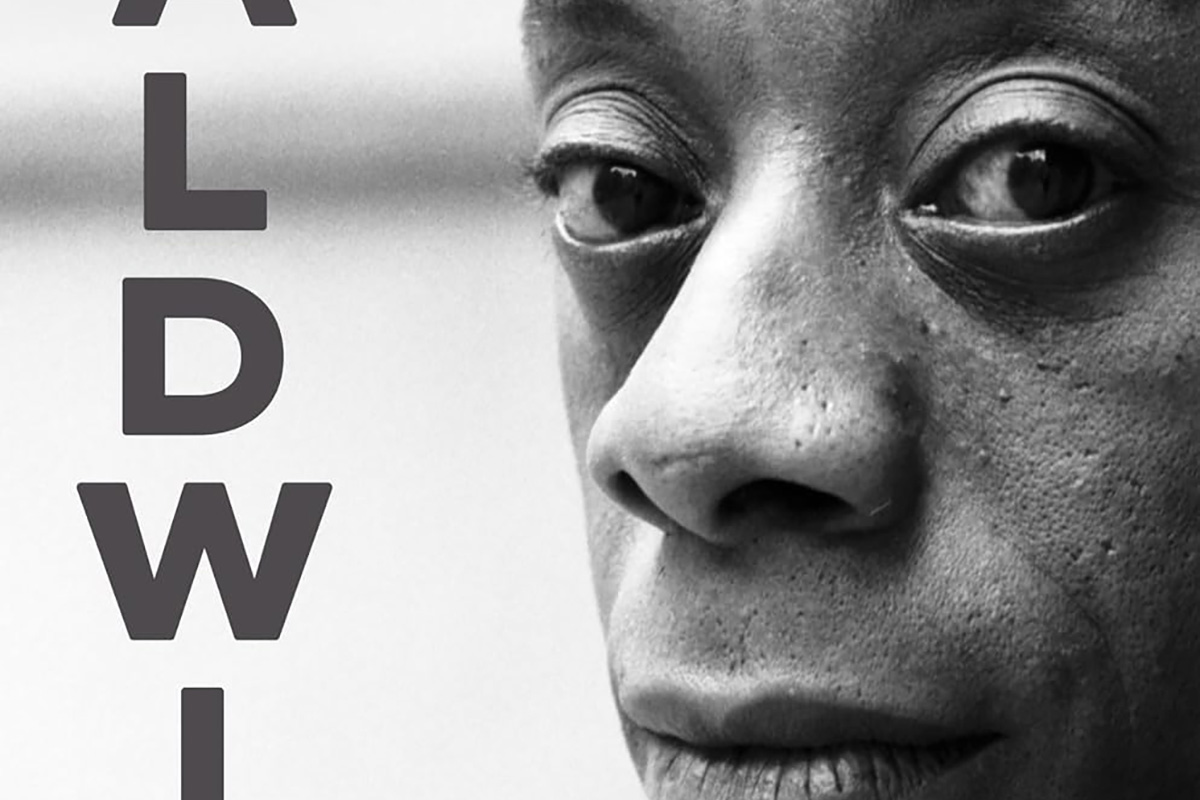
‘Baldwin: A Love Story’
By Nicholas Boggs
c.2025, FSG
$35/704 pages
“Baldwin: A Love Story” is a sympathetic biography, the first major one in 30 years, of acclaimed Black gay writer James Baldwin. Drawing on Baldwin’s fiction, essays, and letters, Nicolas Boggs, a white writer who rediscovered and co-edited a new edition of a long-lost Baldwin book, explores Baldwin’s life and work through focusing on his lovers, mentors, and inspirations.
The book begins with a quick look at Baldwin’s childhood in Harlem, and his difficult relationship with his religious, angry stepfather. Baldwin’s experience with Orilla Miller, a white teacher who encouraged the boy’s writing and took him to plays and movies, even against his father’s wishes, helped shape his life and tempered his feelings toward white people. When Baldwin later joined a church and became a child preacher, though, he felt conflicted between academic success and religious demands, even denouncing Miller at one point. In a fascinating late essay, Baldwin also described his teenage sexual relationship with a mobster, who showed him off in public.
Baldwin’s romantic life was complicated, as he preferred men who were not outwardly gay. Indeed, many would marry women and have children while also involved with Baldwin. Still, they would often remain friends and enabled Baldwin’s work. Lucien Happersberger, who met Baldwin while both were living in Paris, sent him to a Swiss village, where he wrote his first novel, “Go Tell It on the Mountain,” as well as an essay, “Stranger in the Village,” about the oddness of being the first Black person many villagers had ever seen. Baldwin met Turkish actor Engin Cezzar in New York at the Actors’ Studio; Baldwin later spent time in Istanbul with Cezzar and his wife, finishing “Another Country” and directing a controversial play about Turkish prisoners that depicted sexuality and gender.
Baldwin collaborated with French artist Yoran Cazac on a children’s book, which later vanished. Boggs writes of his excitement about coming across this book while a student at Yale and how he later interviewed Cazac and his wife while also republishing the book. Baldwin also had many tumultuous sexual relationships with young men whom he tried to mentor and shape, most of which led to drama and despair.
The book carefully examines Baldwin’s development as a writer. “Go Tell It on the Mountain” draws heavily on his early life, giving subtle signs of the main character John’s sexuality, while “Giovanni’s Room” bravely and openly shows a homosexual relationship, highly controversial at the time. “If Beale Street Could Talk” features a woman as its main character and narrator, the first time Baldwin wrote fully through a woman’s perspective. His essays feel deeply personal, even if they do not reveal everything; Lucian is the unnamed visiting friend in one who the police briefly detained along with Baldwin. He found New York too distracting to write, spending his time there with friends and family or on business. He was close friends with modernist painter Beauford Delaney, also gay, who helped Baldwin see that a Black man could thrive as an artist. Delaney would later move to France, staying near Baldwin’s home.
An epilogue has Boggs writing about encountering Baldwin’s work as one of the few white students in a majority-Black school. It helpfully reminds us that Baldwin connects to all who feel different, no matter their race, sexuality, gender, or class. A well-written, easy-flowing biography, with many excerpts from Baldwin’s writing, it shows how much of his life is revealed in his work. Let’s hope it encourages reading the work, either again or for the first time.

